If you’ve ever dreamed of living in an intentional community — surrounded by people who share your values — one of your first questions might be: How much does it cost to live in an intentional community?
It can be disheartening to get excited about joining an intentional community, only to be discouraged by the high cost to join. You might find yourself scrolling through listings, inspired by what you see yet feeling defeated when you realize how few options fit within your budget.
Many people share that same experience. Every week I hear from individuals who dream of living in community but have little or no money to put toward it. They long for connection, sustainability, and shared purpose, yet are being priced out of the very lifestyle that could provide those things.
The truth is, how much it costs to live in an intentional community varies widely depending on location, type of community, and your own lifestyle choices. Some communities are surprisingly affordable, while others feel out of reach for the average person.
Let’s explore what to expect, why costs vary so much, and how you can make community living more financially accessible — even on a modest budget.
If you’re interested in learning more about how to find affordable intentional communities that might align with your values and budget, check out the Money & Community online mini-course, which goes into the topics below in much greater detail.
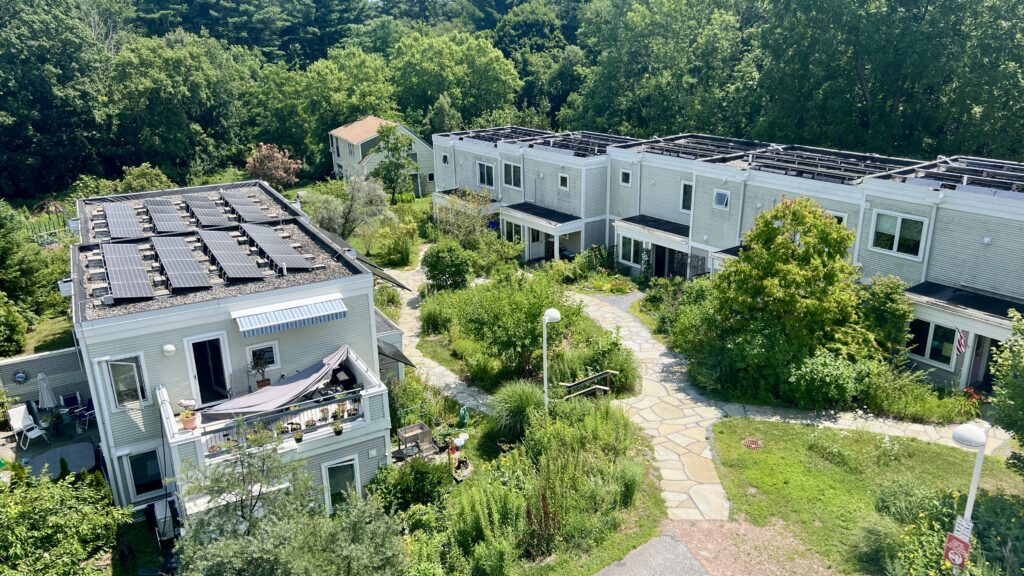
The Housing Crisis (and why communities aren’t immune)
We’re in the middle of a global housing crisis, with skyrocketing prices and shrinking affordability. Intentional communities aren’t immune to these pressures. Sometimes people assume that intentional communities “should” be utopian islands where everyone can live freely with no costs. The reality is that communities must pay for land, construction, and maintenance just like everyone else, doing the best they can within our capitalist economy.
Some communities, especially those in desirable areas, can be just as expensive as traditional housing, particularly those based on homeownership models like cohousing. For many, this makes community living seem unattainable.
However, many intentional communities are actively experimenting with creative models — shared ownership, cooperatives, land trusts, and income-sharing — that can make communal living more affordable.
See my article on How Intentional Communities Are Solving the Housing Crisis for more on what communities are doing to become part of the solution.
Resources if You’re in Crisis
If you or someone you know urgently needs housing, intentional communities may not be the best immediate solution. Joining often requires a significant investment of time — sometimes months or even years — and may not be suitable if you’re in a housing crisis.
If you are currently in a housing crisis: Help is available. In the U.S., you can call 2-1-1 to connect with local housing and emergency services. You can also contact the HUD Housing Counseling Hotline at 1-800-569-4287 for free guidance, or if you are a veteran, call 1-877-4AID-VET (1-877-424-3838) for 24/7 support.
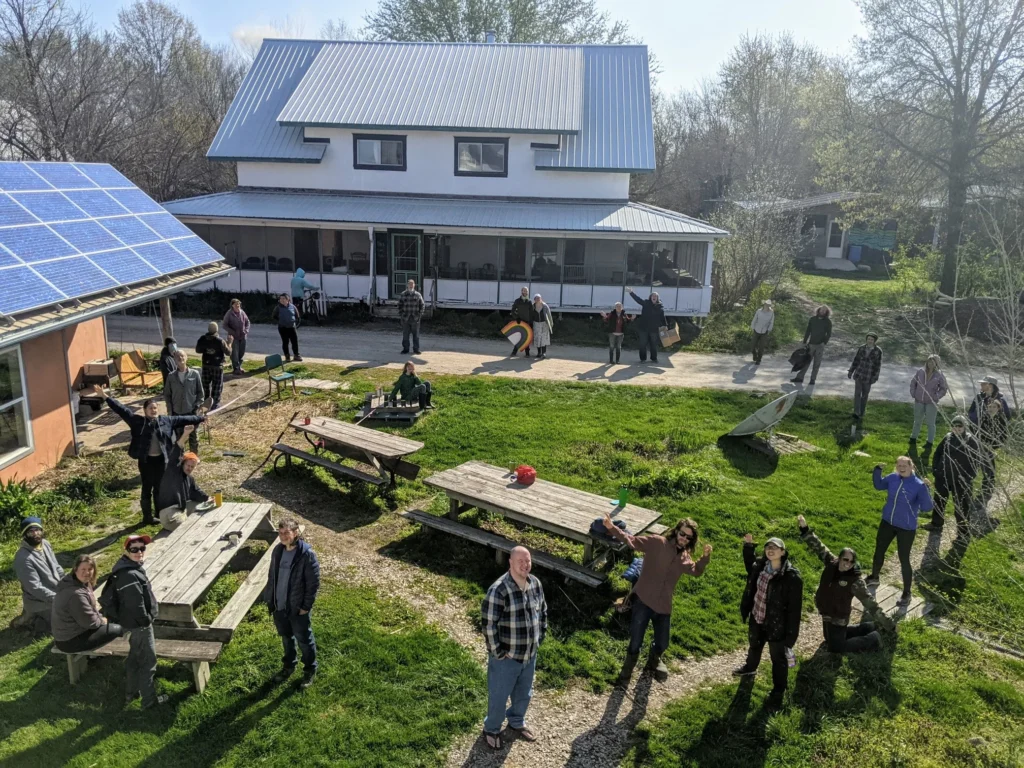
How much does it cost to live in an intentional community? It depends.
Just like in mainstream housing, geography makes a huge difference. Communities located on the West Coast or near major cities often have higher property values and living costs. By contrast, communities in rural areas or regions with lower land prices can offer more affordable entry points.
- For example, at Rooted Northwest, a newly forming cohousing community outside Seattle, homes start around $800,000, reflecting the high real-estate costs of the Pacific Northwest.
- In contrast, at Earthaven Ecovillage in rural North Carolina, members can rent an apartment for as little as $400 per month, with many residents offsetting costs through work exchange.
- Meanwhile, at an income-sharing community like Twin Oaks Community in Virginia, it’s possible to join at zero cost provided you’re willing to work within the community’s businesses.
These examples show just how much it can vary — from modern, mortgage-based homeownership models to low-cost, off-grid living arrangements. Exploring communities in different regions — or even different countries — can open up far more affordable options that align with your values and financial reality.

Understanding Different Types of Intentional Communities (and their costs)
Each type of intentional community has a different financial structure. Understanding these differences can help you find the right fit for your situation.
- Cohousing communities are typically based on homeownership. If you don’t have the cash to purchase outright or don’t qualify for a mortgage, cohousing may not be your best option right now — though there are exceptions, as discussed below.
- Co-ops and housing collectives often use a shared ownership or rental model, with monthly dues instead of large buy-ins.
- Income-sharing communities (like Twin Oaks or Acorn) pool income and share expenses. There’s usually no buy-in cost, but members are expected to work within the community’s businesses.
- Ecovillages vary widely — from rural off-grid projects to intentional neighborhoods with modern amenities. Some have ownership models, while others offer rentals or work-trade opportunities. In some, you can build your own home or park a tiny house.
- Community Land Trusts (CLTs) are non-profit models designed for affordability. Instead of buying a home outright, members usually hold a 99-year lease to the home or land. This removes property from the speculative real estate market, keeping entry costs accessible, though it limits the ability to build equity.
- Coliving communities are often found in urban centers. They offer affordable living with shared spaces for connection but are usually owned by commercial entities and not designed for families. Still, they can be an excellent entry point for young people exploring community life in cities.
- ROC Manufactured Home Communities are among the most affordable community types, with more than 200 across the United States and growing. These are resident-owned cooperatives that have collectively bought out their landlords and steward their communities together.
See my article on Types of Intentional Communities to understand these models in more detail.
The Community Price Spectrum: A visual guide to the cost of living in intentional communities
To help visualize how diverse these financial structures can be, take a look at the Community Price Spectrum below:
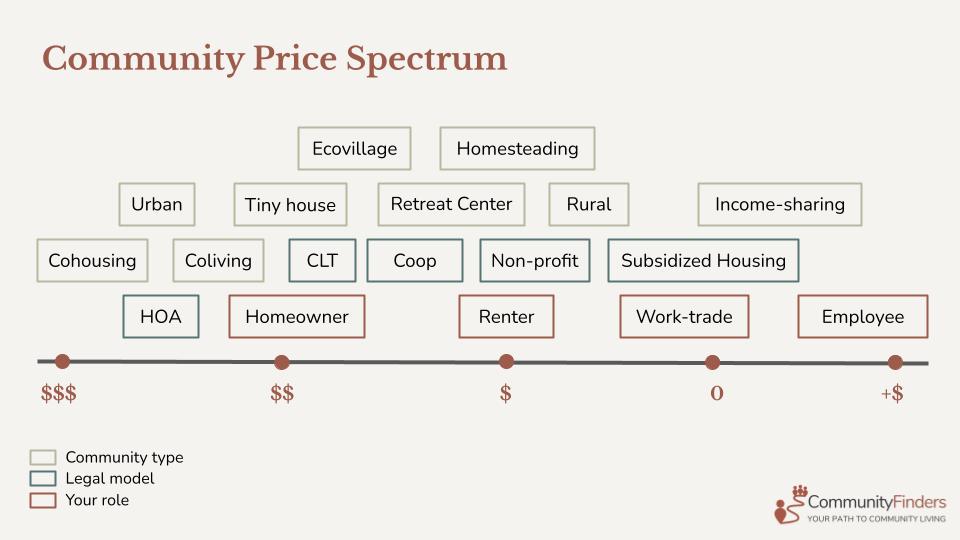
This chart illustrates the range of community types, legal models, and individual roles — and how each typically aligns along a cost spectrum.
- On the left, you’ll see higher-cost models like cohousing and urban homeowner associations, where residents purchase homes and pay ongoing fees.
- In the middle are moderate-cost options like rural ecovillages, cooperatives, or community land trusts, where costs are shared among members.
- On the far right are low-cost or even income-positive models — such as work-trade and income-sharing communities — where your contribution of labor or shared income offsets most or all housing costs.
In my mini-course on Affording Community Living, I walk through this spectrum in detail — explaining how to identify which models best fit your personal budget, financial goals, and lifestyle.
Self-Assessment Questions: How will you be able to afford community housing?
If you’re considering community living, it helps to assess your financial situation and flexibility.
Ask yourself:
- Do I qualify for a mortgage, or would I need to rent or co-own?
- What’s my housing budget, and how much do I pay now?
- Could I rent or sublet my current home while trying out community life?
- Do I have friends I could share housing with?
- Am I open to part-time or full-time work within a community to offset housing costs?
- Would I want to live in an income-sharing community?
- Could I get by with a smaller space and live more closely with others?
- Am I willing to downsize? Living in community often means living smaller but sharing more. You may not need a guest room or large kitchen when these are available to everyone.
Remember too, once you live in community, your everyday living expenses may drop because you need less stuff and more amenities are shared.

Rethinking What “Home” Means: When considering the cost of living in an intentional community
Moving into community isn’t just a financial change — it’s a mindset shift. Instead of measuring success by square footage or possessions, you begin to value shared abundance: gardens, guest rooms, libraries, workshops, and communal spaces.
Downsizing can actually feel liberating. Many people realize they need far less private space when they gain access to shared amenities and a supportive social fabric.
Don’t let sticker shock stop you — get curious. Joining a community is not the same as purchasing a home on the traditional real estate market. This is about building relationships.
Once you have a relationship with a community, a world of possibilities may open up.
For example, a member of Rachel Carson Ecovillage shared that she was initially unable to buy into the community due to high costs, but with patience and deep relationship-building she was later able to join through a subsidized lease-to-own unit.
Another story comes from a member of Sawyer Hill Ecovillage. Though he couldn’t purchase a community home outright, residents helped connect him with two other prospective members. Together, they arranged to co-purchase a home under a special rent-to-own agreement, becoming equal co-owners over time.
These examples show that when a community values you, creative solutions often follow.
Get Creative With Your Path to Community
Before anything else, ensure the community is a mutual fit. They need to be excited about you joining and willing to explore creative possibilities with you.
Here are some ideas to discuss with a potential community:
- Try a short-term visitor stay or volunteer program.
- Rent or sublet your current home to fund a trial period.
- Share a house with friends as a stepping stone.
- Explore community land trusts or affordable co-ops nearby.
- Ask if the community can match you with co-buyers.
- Inquire whether you could park a tiny home or other accessory dwelling unit (ADU) on-site.
- See if anyone in the community is looking for a housemate.
- Offer specific services in exchange for reduced housing costs.
- Develop a business or side income to increase your capital.
- Ask about member-to-member loans or socially responsible financing options.
- Explore whether the community accepts housing vouchers.
- Work with the community to create or transition to subsidized housing through nonprofit or government programs.
Intentional community living is about experimentation, creativity, and connection. Many people within communities genuinely want to be part of the affordability solution.
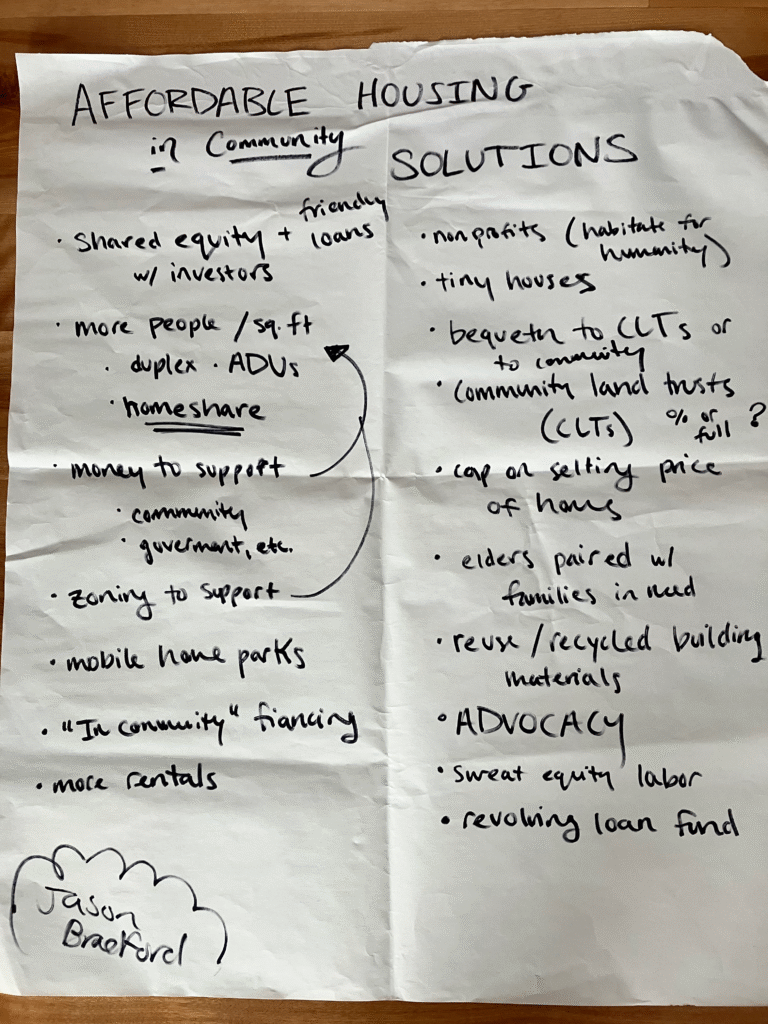
The Real Cost — and Value — of Living in an Intentional Community
When people ask “how much does it cost to live in an intentional community,” the honest answer is: it depends. It depends on the community type, location, your role, and how you define “enough.”
But perhaps a better question is: what’s the cost of not living in community?
The loneliness, stress, and instability of modern life take their own toll.
Intentional community isn’t just about lowering expenses — it’s about investing in relationships and shared resilience. Even if it costs a bit more, that investment can be profoundly worth it.
Want to learn more?
If you’re ready to find a community that fits both your budget and your lifestyle, I’ve created a short and inexpensive online course that walks you through how to:
- Discover affordable community options
- Understand different financial models
- Create a realistic budget for your transition
Join the Mini-Course: How to Find and Afford Your Ideal Intentional Community
It’s the perfect next step if you’re ready to move from dreaming to doing!

Share your experience about how much it costs to live in an intentional community
I’d love to hear from you. Have you explored living in an intentional community, or are you currently part of one? What challenges or creative solutions have you encountered around affordability and access?
Share your thoughts and questions in the comments below — your story could help inspire someone else who’s wondering how much it costs to live in an intentional community and whether it’s possible for them too.















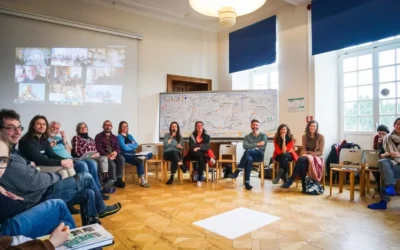
Really helpful thank you!
RiverFolk Cohousing Permaculture here in Vermont considers it a vital part of our mission to allow access to this lifestyle, living off-grid and close to the Earth.
Hosted WWOOFers and almost “anyone” looking for work exchange for 16 years in one of the harshest climates (AZ high desert). Met many amazing people and made friends.
I love a challenge, science, experimenting, harnessing nature, and doing what nobody’s done before. Roman “concrete”, pueblo-type housing for extreme natural temperature control, sand batteries, growing organic food, etc.
There are “normal” people living here, in their air-conditioned firetraps, watching TV all day or hacking away on their stupid phones. I have friends and neighbors, but little in common with them.
I considered selling my property and looked at other communities. I spent a day reading their website and completing an extremely long form for a community overseas and didn’t even get a reply. My favorite community in the US required $500,000 to purchase a lot, and then the funds to build a house.
The activist communities are in the cities, not for me. I like my privacy and wanted to start a tiny house community, possibly with others owning their own property in the neighborhood. Sharing resources and dinners. Why does everybody need at least two vehicles to survive here? Why not share a waterhauler? Why not purchase organics in bulk to bring the cost down?
I joined AZ off-grid and homesteading groups on Facebook, but I’m not a prepper or MAGA. And it’s too painful to read about the many people with dreams of homesteading, wasting their money on worthless land. I used to run the gardening club and watched so many epic fails, again and again, because they chose to watch the stupid YouTube videos glorifying desert homesteading, grifting off the gullible –instead of being part of a “community” sharing resources and experiences.
Most people are just looking for cheap living, eating the Family Dollar “food”, with as little work as possible. And that’s the state of the planet, sadly. So few intellectuals. People are ranting and raving about injustices, but “doing” nothing to create change on any level. Care only about themselves.
It’s so frustrating to see people in Facebook groups wanting to join a community, waiting for the silver platter with the key to their new home. Most people are so afraid of everything.
Great article, Cynthia.
On this point: “Inquire whether you could park a tiny home or other accessory dwelling unit (ADU) on-site.” You might want to mention RV’s as they can be had for $1000 or even less sometimes. We have 6 rv/tiny house sites here at Harmony Woods and even offer work exchange for utilities and lot rent.
Great idea, thank you Paul!